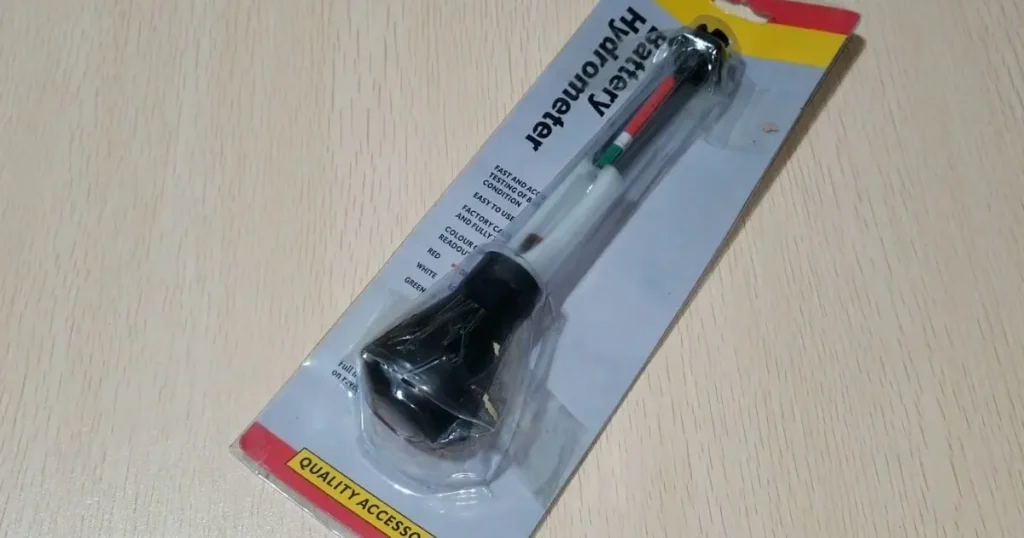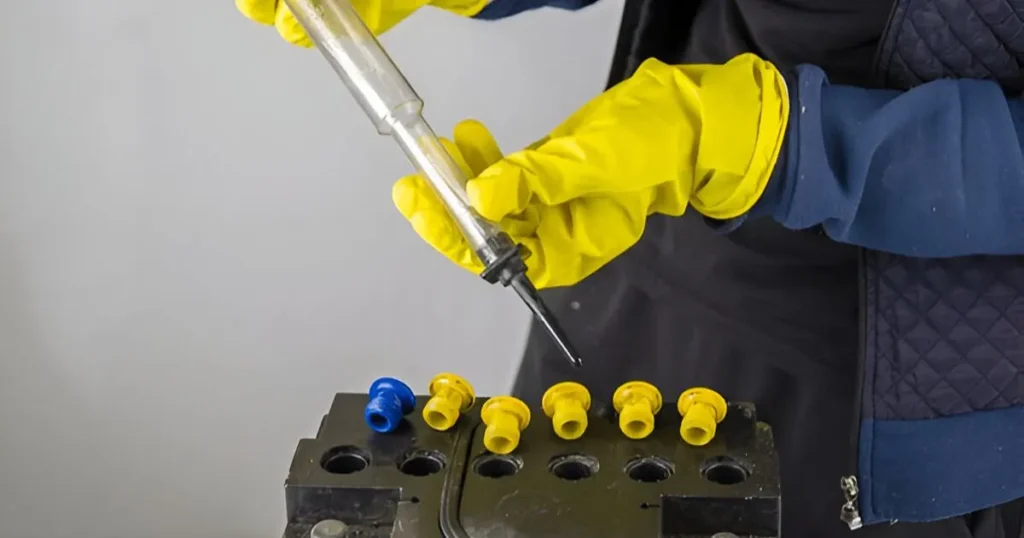
A car hydrometer measures the specific gravity of a battery's electrolyte solution. It indicates the battery's state of charge.
Understanding your vehicle's battery health is essential, especially to avoid unexpected breakdowns. A car hydrometer is a tool that simplifies this task by providing a quick assessment of the battery's charge level. Typically, it consists of a squeeze bulb, a tube, and a floating gauge.
The device works by drawing a sample of the battery's electrolyte into the tube, allowing the float to rise to a level corresponding to the electrolyte's density. This reading helps determine whether the battery is fully charged, needs charging, or potentially has a faulty cell.
Regular use of a hydrometer can help extend your car battery's life by ensuring it is maintained at the correct charge, and also preemptively signal when it's time for a replacement.
Introduction To Car Hydrometer
Welcome to the world of car maintenance, where understanding the health of your car's battery is crucial. A car hydrometer is a simple, yet essential tool in assessing a battery's condition. Let's dive into how this tool works and why it's important for every car owner to know about it.
The Basic Concept
A car hydrometer measures the specific gravity of a battery's electrolyte solution. This tells us about the battery's charge level. The tool has a small reservoir and a suction bulb. It draws liquid from the battery and shows a reading.
The hydrometer has a floating ball or needle that rises with the electrolyte density. A higher density indicates a fully charged battery. A lower density suggests the battery needs charging.
Why It Car Hydrometer
Regular battery checks keep cars running smoothly. A hydrometer alerts you to potential battery issues before they worsen. Knowing the battery's state can prevent breakdowns and maintain performance.
- Save money by avoiding unexpected battery replacements.
- Extend battery life with timely maintenance.
- Ensure reliability of your vehicle on the road.

The Science Behind Car Hydrometer
The Science Behind Hydrometers is fascinating. This tool measures the specific gravity of liquids. In cars, it checks battery acid. Let's dive into how it works.
Measuring Specific Gravity
A hydrometer floats in a liquid. Its level shows the liquid's density. A denser liquid makes the hydrometer sink less. This reading helps us understand the liquid's specific gravity.
- The scale on the hydrometer gives the specific gravity.
- For car batteries, specific gravity tells us the charge level.
How Temperature Affects Readings
Temperature changes liquid density. This affects hydrometer readings.
Warmer liquids expand, becoming less dense. The hydrometer sinks more.
Colder liquids shrink, becoming denser. The hydrometer sinks less.
| Temperature | Effect on Liquid Density | Hydrometer Reading |
|---|---|---|
| Warm | Decreases | Sinks More |
| Cold | Increases | Sinks Less |
Always adjust readings for temperature. This ensures accuracy.
Components Of A Car Hydrometer
Understanding how a car hydrometer works starts with its components. Each part plays a crucial role in measuring the specific gravity of the battery's electrolyte. This tells us about the battery's health and charge level.
Main Parts Explained
Car hydrometers consist of several key elements:
- Bulb: Sucks in the electrolyte.
- Reservoir: Holds the liquid for testing.
- Float: Indicates the specific gravity.
- Scale: Shows the gravity reading.
Materials Used
Manufacturers choose materials that resist battery acid and provide durability:
| Component | Material |
|---|---|
| Bulb | Rubber |
| Reservoir | Acid-resistant plastic |
| Float | Glass or Plastic |
| Scale | Plastic or Paper |

Step-by-step: Using A Car Hydrometer
Maintaining your car's battery is crucial. A car hydrometer checks battery health. It measures the specific gravity of the battery acid. This tool is simple and effective. Follow these steps to use a car hydrometer correctly.
Preparation And Safety
- Wear safety gear: Gloves and goggles are a must.
- Check for damage: Inspect the hydrometer for cracks or leaks.
- Read instructions: Familiarize yourself with the hydrometer.
- Clean battery: Remove dirt from the battery surface.
- Remove caps: Open the battery's cell caps carefully.
Reading And Interpreting Results
- Squeeze bulb: Draw acid into the hydrometer.
- Level eyesight: Hold the hydrometer at eye level.
- Note reading: Check where the fluid level meets the scale.
- Check each cell: Repeat for all battery cells.
- Interpret results: Compare readings to the chart provided.
Green or high readings mean a good charge. Low or white readings suggest a charge is needed. Replace the battery if readings are consistently low. Regular checks keep your car's battery in top shape.
Common Applications In Automotive Maintenance
The health of a car often depends on regular checks. A car hydrometer is a tool. It measures fluid densities. Mechanics use it often. It ensures vehicles run smoothly.
Battery Maintenance
Car batteries need care. A hydrometer checks battery acid. It ensures proper charge levels. This test is simple yet vital. It prevents failures. Mechanics use it during service.
Engine Coolant Testing
Coolant health is crucial. It keeps engines at the right temperature. The hydrometer measures coolant density. It helps detect potential issues. Mechanics test it during oil changes.
| Tool | Use | Checks |
|---|---|---|
| Hydrometer | Battery | Acid Level |
| Hydrometer | Coolant | Density |

Troubleshooting: Common Issues And Solutions
Knowing how to fix common hydrometer problems is key. This section covers typical issues and how to solve them.
Inaccurate Readings
Inaccurate readings can mislead. Follow these steps:
- Check the temperature. Use a correction chart if needed.
- Ensure the hydrometer is clean. Residue skews results.
- Calibrate regularly. Use distilled water for accuracy.
- Read at eye level. Avoid parallax errors.
Physical Damage
Physical damage affects performance. Look for:
- Cracks or chips. These can alter buoyancy.
- Dislodged weights. They change the balance.
- Sticky float. Clean it for smooth movement.
Replace if damage is severe. Regular checks prevent major issues.
Improving Accuracy: Tips And Tricks
Measuring your car's battery fluid is crucial. A car hydrometer helps with this. It checks the battery's health. For accurate readings, follow these tips and tricks.
Calibration Techniques
Calibration makes a hydrometer accurate. Start with these steps:
- Use distilled water. Fill the hydrometer. Check the reading. It should say 1.000. If not, adjust.
- Check at room temperature. Temperature affects readings. Always use it in a room with mild temperature.
- Repeat before use. Calibrate it often. This ensures accuracy.
Avoiding Common Mistakes
To get the best out of your hydrometer, avoid these:
- Not cleaning. Always clean it after use. Sticky residue can alter future readings.
- Ignoring leaks. Check for leaks often. Leaks can cause wrong readings.
- Using it roughly. Handle it with care. Dropping can damage it.

The Future Of Car Maintenance And Hydrometer
The future shines bright for car maintenance, with hydrometers at the forefront. These devices are crucial for monitoring battery health. They measure the specific gravity of the battery acid, which indicates charge levels. As technology evolves, so do the tools we use for vehicle upkeep. Hydrometers are no exception, embracing new features that promise to simplify car maintenance.
Technological Advancements
Modern hydrometers are becoming more sophisticated. Digital displays now replace the traditional floating ball mechanism. This provides quicker and more accurate readings. Smart hydrometers with Bluetooth capabilities allow for remote monitoring. Car owners can check their battery's health via a smartphone app.
- Smartphone integration - Monitor your battery from anywhere.
- Automated alerts - Receive notifications for low battery levels.
- Historical data analysis - Track battery performance over time.
Emerging Trends
As the automotive industry leans towards electric vehicles (EVs), hydrometers adapt. New models are designed for the complex batteries in EVs. They help ensure optimal performance and longevity. Predictive maintenance software uses hydrometer data to forecast battery issues before they arise. This trend leads to fewer breakdowns and less downtime for drivers.
| Trend | Benefit |
|---|---|
| EV-focused designs | Tailored to modern battery types |
| Predictive maintenance | Prevents unexpected failures |
| Data-driven diagnostics | Enhances battery care |
With each technological stride, car maintenance becomes more intuitive and efficient. Hydrometers are set to play a key role in this evolution, providing critical insights into vehicle health and helping to shape the future of automotive care.
Related Post
Top 7 Reasons Your Car Tachometer Might Be Out of Service: Critical Insights
Expert Tips: Master Car Maintenance with a Vacuum Gauge!
Car Temperature Gauge Drops: Quick Fixes & Tips
Why Your Car Water Temperature Meter Safeguards Engine Health
Oil Pressure Gauge Essentials: Must-Know Tips for Drivers
How Does a Car Dynamometer Work: Unveil the Power!
Conclusion
Understanding the functionality of a car hydrometer is essential for any vehicle owner. This simple tool ensures your battery's health, safeguarding against unexpected breakdowns. Remember, regular maintenance, including hydrometer checks, can prevent costly repairs. Keep your journey smooth by staying informed and proactive about your car’s battery care.
Disclosure
Some links may be affiliate links. That means we may earn a small commission at no extra cost to you.